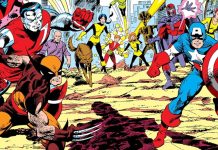Marvel is no longer selling periodical comics to Barnes and Noble and Books-a-Million, the two largest chain book stores. Good-Ereader confirmed this with employes at both stores.
Barnes and Noble has a flagship store in Union Square, in New York City. This is the location where they tend to have unveiling events for the Nook product line. Two sources at this store have confirmed that they will no longer sell single issue Marvel Comics. An official Barnes and Noble spokesman has also confirmed that they will continue to sell graphic novels and trade paperback editions of Marvel properties, because they are sourced through Hachette. Customers will still be able to purchase single issues produced by DC and Dark Horse.
Books-A-Million has also confirmed that they are no longer carrying Marvel titles at the head office. Contacts within the receiving and ordering departments have said that Marvel titles are simply not available on their lists anymore. They are basically unable to order single issues comics at all.
It’s been confirmed that this was Marvel’s decision, and Marvel hasn’t returned any answers to press inquires as to why they made the move.
While Michael Koslowski at Good-ereader speculates that this may be somehow tied in to Marvel’s evolving secretive plans to develop their own digital all-in-one app, to say there must be a reason for all this that isn’t readily apparent is an understatement. (Some had speculated this might be retaliation for Marvel’s comics not being available on Nooks—as with now B&N removed DC graphic novels after they went exclusive digitally on Amazon—but that is not the case.)
It’s also surprising given that Marvel has definitely been increasing its bookstore presence slowly but clearly, with an original graphic novel line that seems to be doing well— and other done-in-one initiatives.
Stepping clearly into the realm of speculation, I can tell you one thing: if this program had been a big money maker, I can’t imagine that Marvel would have stopped it in a million years. Or a Books-a-million years, if you prefer.
And finally, for those who hold onto the touching 80s notion that “if only we could get comics on newsstands we could save comics!”, I got news for you. Demolition. Setting aside the fact that comics have probably been saved, “newsstands” can’t save Newsweek magazine anymore, let alone Scarlet Spider.
*****
Above photo of a rack of bagged, alarming comics taken at liquidation center Remy’s Underground in Damariscotta, Maine, December 2012.









Given that Marvel has pretty gone the $4 a book route, it’s hard for me to imagine they were selling well in the general market.
And…
“Setting aside the fact that comics have probably been saved”
According to icv2.com
#1 comic November 2013 – 125,602 issues
#1 comic November 2007 – 145,821 issues
#1 comic November 2001 – 156,959 issues
The numbers look good for the comic biz, but let’s see what shape the industry is in after the next downturn before we talk of it being “saved”.
Mike
Marvel distributed to bookstores (and other retailers) through an agreement with Source Interlink, a magazine distributor. If this is Marvel’s call, to cease distribution, it would seem that their relationship with Source Interlink has ended, leaving Diamond as their sole single-issue distributor.
Marvel’s arrangement with Source dated back to 2004:
http://www.businesswire.com/news/home/20040325005043/en/Source-Interlink-Distribute-Marvel-Comics-Company-Expands
I’d seen the titles missing from bookstores — and no, they weren’t accounting for much. The Direct Market, for its part, will be up about 9% in dollars and 7% in units this year; no idea whether that compensates for copies sold in the other market, but I would expect Marvel’s profit per copy in the book channel was much, much lower.
The newsstand is traditionally where parents bought comics for kids, (which is why it was and remains a bigger part of Archie’s model) but a lot of that traffic has simply gone across the store to the graphic novel aisle. There’s a sticker-shock with comic-book pricing that isn’t there to the same degree with graphic novels — parents remember paying $1 for a comic book, whereas they don’t have the same context to draw upon when buying a big full-color compendium. So this occasion is a lesser lament than when newsstand racks left stores in the 1970s and 1980s — at least this time, comics are still being sold there, and likely in a more profitable form.
(Comparing at the sales of the top-selling comic book isn’t a very reliable method for determining market health, by the way, since those items are, by definition, outliers; the data’s too spiky. A comparison of Octobers instead of Novembers would make 2013’s representative Walking Dead #115, with sales of more than double October 2001. I’ve long though the improved performance of the books at the bottom of the charts has been more meaningful, over time. Many of those books never had any newsstand distribution at all, of course.)
Comments are closed.